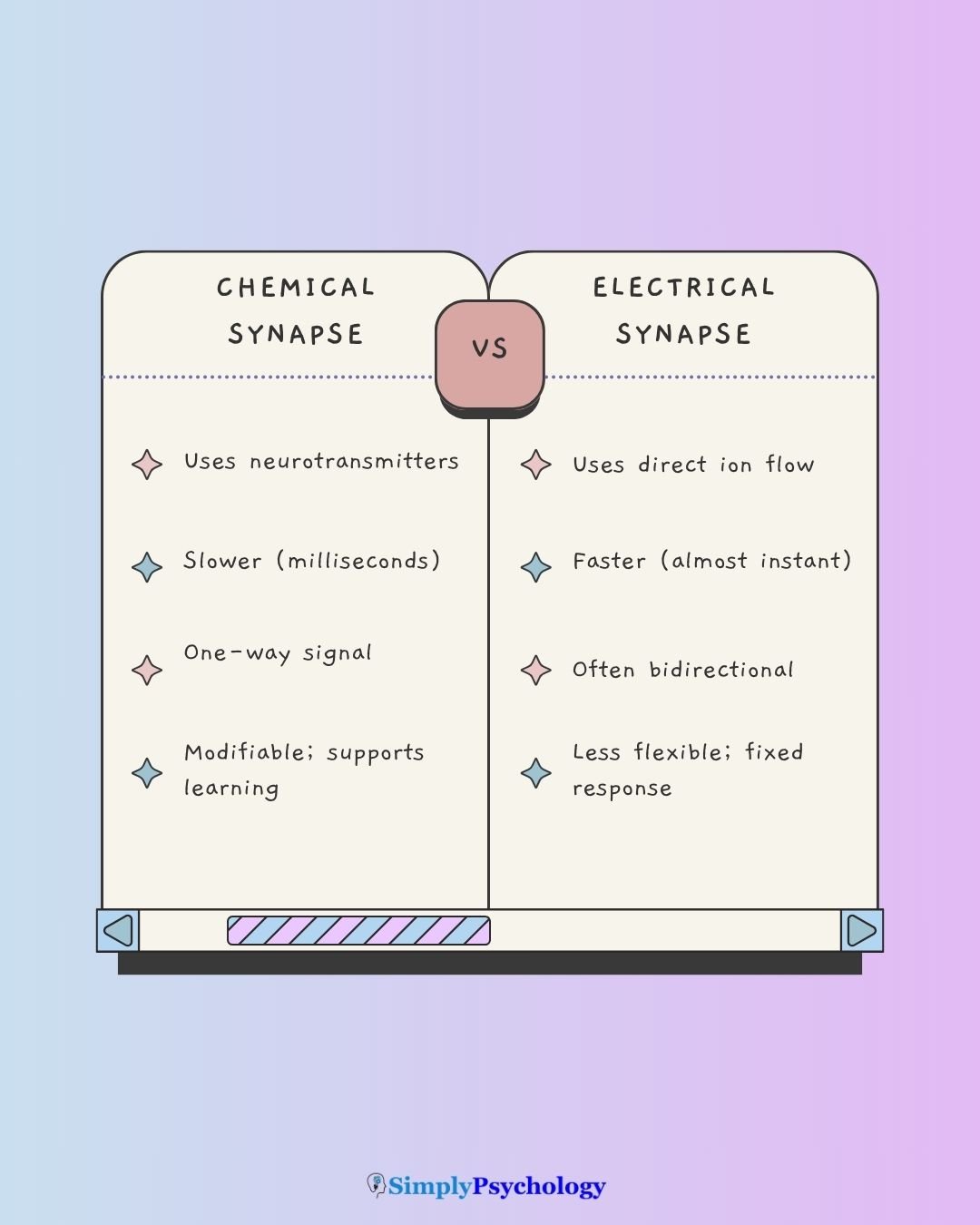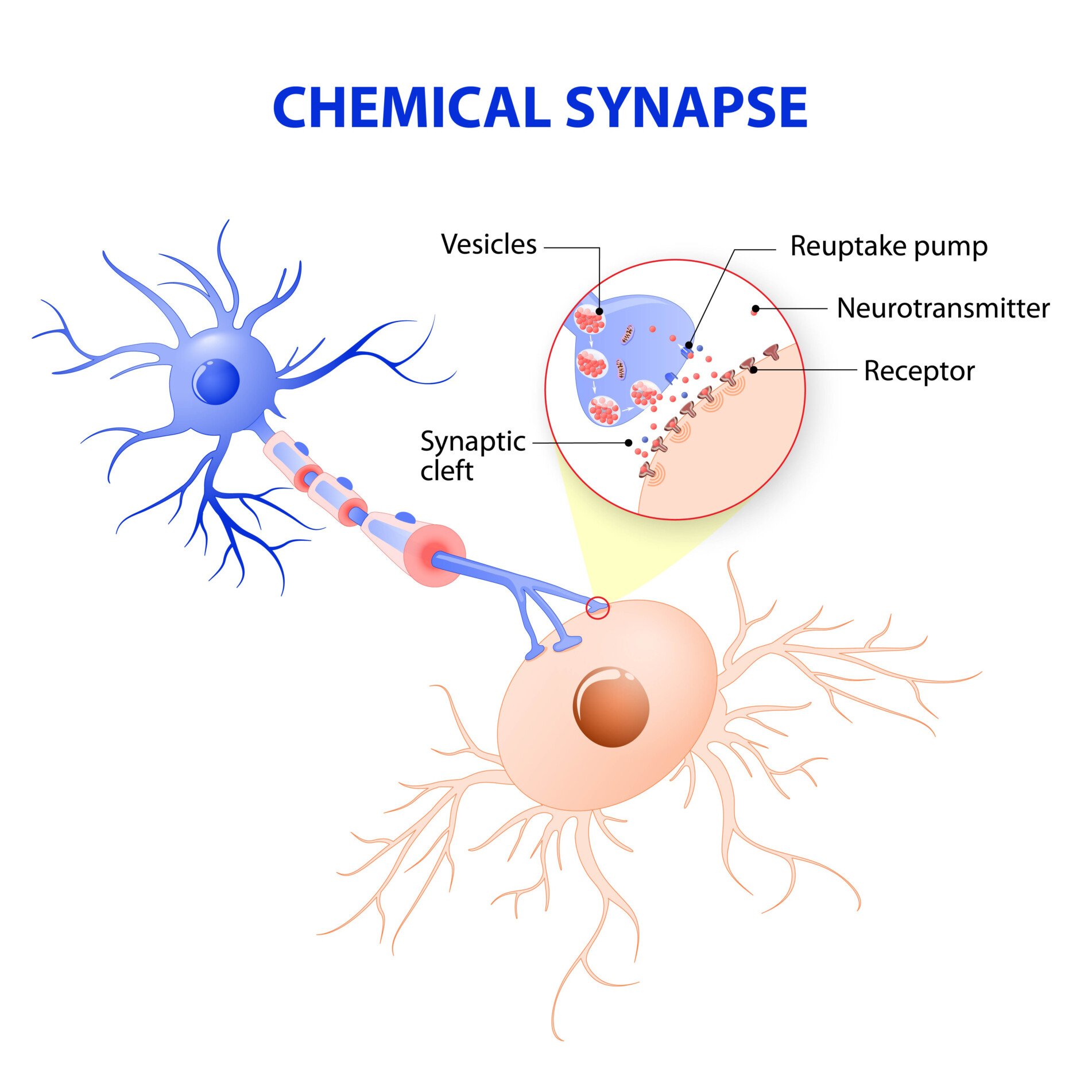There are two main types of synapses: chemical and electrical.
The main difference between chemical and electrical synapses is how they transmit signals—chemical synapses use neurotransmitters to send messages across a small gap, allowing for flexible and complex communication, while electrical synapses pass signals directly through gap junctions, enabling much faster but less modifiable transmission.

What Are Synapses?
A synapse is the tiny gap between two neurons—or between a neuron and a target cell, like a muscle or gland—where information is transmitted.
Synapses are essential for communication within the nervous system and are where one neuron influences the activity of another.
Why Synapses Matter
Synapses allow neurons to pass signals through electrical or chemical means. This communication drives everything from movement and memory to emotion and perception.
Many psychoactive drugs work by altering how neurotransmitters act at synapses.
Chemical Synapses
How They Work
In a chemical synapse, an electrical signal (action potential) reaches the end of a neuron’s axon—called the terminal button. This triggers the release of neurotransmitters, chemical messengers stored in synaptic vesicles.
These neurotransmitters cross the synaptic cleft (a 20-nanometer-wide gap) and bind to receptors on the next neuron, passing on the message.
Neurotransmitters and Receptors
Neurotransmitters work like keys in a lock, only binding to specific receptors:
- Acetylcholine – involved in muscle movement and memory
- Dopamine – affects mood, reward, learning, and sleep
- Serotonin – linked to mood, pain, sleep, and digestion
- Norepinephrine – influences alertness, heart rate, and mood
- GABA – the brain’s main inhibitory neurotransmitter
- Glutamate – the main excitatory neurotransmitter involved in learning
After they do their job, neurotransmitters are either broken down by enzymes or taken back into the sending neuron through reuptake, clearing the synapse for future signals.
Synaptic Delay
Chemical transmission is fast but not instantaneous. The entire process—from neurotransmitter release to receptor activation—takes a few milliseconds.
One-Way Flow
Chemical synapses transmit messages in one direction: from the presynaptic neuron (sender) to the postsynaptic neuron (receiver).

Electrical Synapses
How They Work
Electrical synapses connect neurons through gap junctions, which are direct, physical links between their cell membranes. Ions (charged particles) flow directly from one neuron to the next.
No Neurotransmitters Needed
Because the signal moves as an electrical current, there’s no need for neurotransmitters. This allows the signal to be transmitted almost instantly.
Speed and Timing
Electrical synapses are faster than chemical synapses, making them ideal for situations requiring quick response times.
Signal Direction
Unlike chemical synapses, electrical signals can often flow in both directions, depending on the arrangement of the gap junctions.
Structural Components
Gap junctions are formed by specialized proteins that link the membranes of two neurons.

Key Differences Between Chemical and Electrical Synapses
| Feature | Chemical Synapse | Electrical Synapse |
|---|---|---|
| Transmission Method | Neurotransmitters | Direct ion flow |
| Speed | Several milliseconds | Instantaneous |
| Signal Direction | One-way (presynaptic to postsynaptic) | Often bidirectional |
| Structure | Synaptic cleft | Gap junctions |
| Neurotransmitter Use | Required | Not required |
Why the Brain Uses Both Types
Different Tools for Different Jobs
The nervous system benefits from having both types of synapses:
- Chemical synapses are better for flexibility, complexity, and long-term changes like learning.
- Electrical synapses are better for speed and synchronized firing.
Functional Examples
- Chemical synapses help control reflexes, memory, and complex behaviors.
- Electrical synapses support the coordination of neuron groups.
Developmental Role
Electrical synapses are more common in early brain development, where speed and synchronization are key. As the brain matures, chemical synapses become more dominant due to their adaptability.
Where Are Electrical Synapses Found?
While less common, electrical synapses are found throughout the central nervous system.
They are found in parts of the brain such as the brainstem, retina, thalamus, and cerebellum, where they help coordinate fast reflexes, rhythmic breathing, and visual processing.
Where Are Chemical Synapses Found?
Chemical synapses are found throughout the brain and nervous system. They play a central role in almost all brain functions, including:
- Learning and memory
- Emotion and motivation
- Muscle movement
- Sensory processing
Their adaptability makes them key to neuroplasticity, the brain’s ability to change and learn over time.
Why Are Chemical Synapses More Common?
More Control and Complexity
Chemical synapses allow for fine-tuned communication. Different neurotransmitters can:
- Excite or inhibit the receiving neuron
- Be amplified or dampened by drugs or feedback mechanisms
- Adapt over time through processes like synaptic plasticity
Support for Learning and Memory
Repeated activation of a chemical synapse can lead to stronger connections—a key part of long-term potentiation, which underlies memory formation.
Summary: Speed vs Flexibility
- Electrical synapses are ideal for fast, synchronized communication, especially during early development or reflexive responses.
- Chemical synapses allow for modulation, complexity, and adaptation, making them essential for thinking, learning, and behavior.

